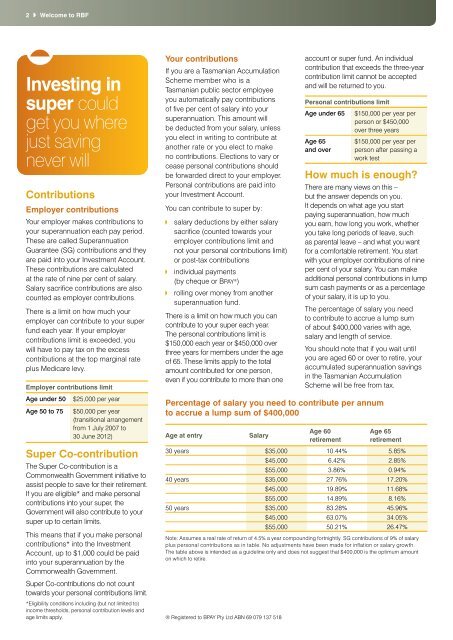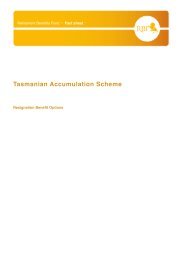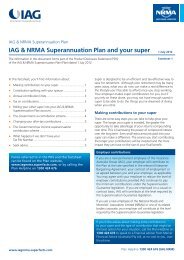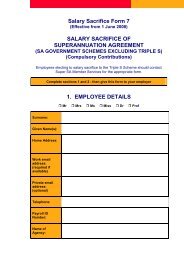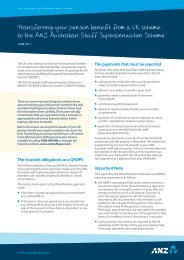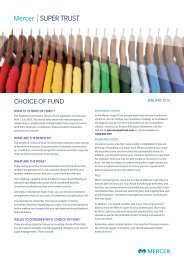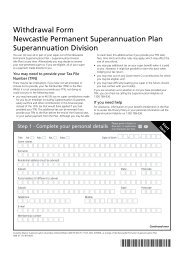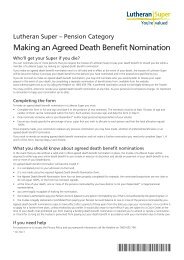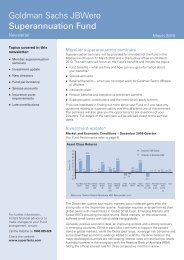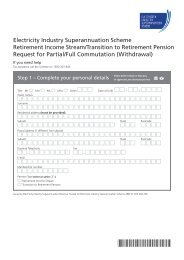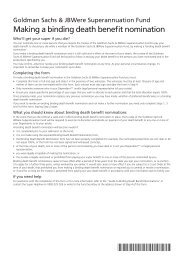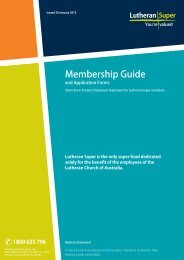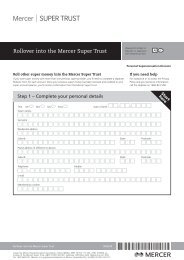Welcome to RBF Information in this brochure is ... - SuperFacts.com
Welcome to RBF Information in this brochure is ... - SuperFacts.com
Welcome to RBF Information in this brochure is ... - SuperFacts.com
Create successful ePaper yourself
Turn your PDF publications into a flip-book with our unique Google optimized e-Paper software.
2 <strong>Wel<strong>com</strong>e</strong> <strong>to</strong> <strong>RBF</strong><br />
Invest<strong>in</strong>g <strong>in</strong><br />
super could<br />
get you where<br />
just sav<strong>in</strong>g<br />
never will<br />
Contributions<br />
Employer contributions<br />
Your employer makes contributions <strong>to</strong><br />
your superannuation each pay period.<br />
These are called Superannuation<br />
Guarantee (SG) contributions and they<br />
are paid <strong>in</strong><strong>to</strong> your Investment Account.<br />
These contributions are calculated<br />
at the rate of n<strong>in</strong>e per cent of salary.<br />
Salary sacrifice contributions are also<br />
counted as employer contributions.<br />
There <strong>is</strong> a limit on how much your<br />
employer can contribute <strong>to</strong> your super<br />
fund each year. If your employer<br />
contributions limit <strong>is</strong> exceeded, you<br />
will have <strong>to</strong> pay tax on the excess<br />
contributions at the <strong>to</strong>p marg<strong>in</strong>al rate<br />
plus Medicare levy.<br />
Employer contributions limit<br />
Your contributions<br />
If you are a Tasmanian Accumulation<br />
Scheme member who <strong>is</strong> a<br />
Tasmanian public sec<strong>to</strong>r employee<br />
you au<strong>to</strong>matically pay contributions<br />
of five per cent of salary <strong>in</strong><strong>to</strong> your<br />
superannuation. Th<strong>is</strong> amount will<br />
be deducted from your salary, unless<br />
you elect <strong>in</strong> writ<strong>in</strong>g <strong>to</strong> contribute at<br />
another rate or you elect <strong>to</strong> make<br />
no contributions. Elections <strong>to</strong> vary or<br />
cease personal contributions should<br />
be forwarded direct <strong>to</strong> your employer.<br />
Personal contributions are paid <strong>in</strong><strong>to</strong><br />
your Investment Account.<br />
You can contribute <strong>to</strong> super by:<br />
salary deductions by either salary<br />
sacrifice (counted <strong>to</strong>wards your<br />
employer contributions limit and<br />
not your personal contributions limit)<br />
or post-tax contributions<br />
<strong>in</strong>dividual payments<br />
(by cheque or Bpay ® )<br />
roll<strong>in</strong>g over money from another<br />
superannuation fund.<br />
There <strong>is</strong> a limit on how much you can<br />
contribute <strong>to</strong> your super each year.<br />
The personal contributions limit <strong>is</strong><br />
$150,000 each year or $450,000 over<br />
three years for members under the age<br />
of 65. These limits apply <strong>to</strong> the <strong>to</strong>tal<br />
amount contributed for one person,<br />
even if you contribute <strong>to</strong> more than one<br />
account or super fund. An <strong>in</strong>dividual<br />
contribution that exceeds the three-year<br />
contribution limit cannot be accepted<br />
and will be returned <strong>to</strong> you.<br />
Personal contributions limit<br />
Age under 65 $150,000 per year per<br />
person or $450,000<br />
over three years<br />
Age 65<br />
and over<br />
$150,000 per year per<br />
person after pass<strong>in</strong>g a<br />
work test<br />
How much <strong>is</strong> enough?<br />
There are many views on <strong>th<strong>is</strong></strong> –<br />
but the answer depends on you.<br />
It depends on what age you start<br />
pay<strong>in</strong>g superannuation, how much<br />
you earn, how long you work, whether<br />
you take long periods of leave, such<br />
as parental leave – and what you want<br />
for a <strong>com</strong>fortable retirement. You start<br />
with your employer contributions of n<strong>in</strong>e<br />
per cent of your salary. You can make<br />
additional personal contributions <strong>in</strong> lump<br />
sum cash payments or as a percentage<br />
of your salary, it <strong>is</strong> up <strong>to</strong> you.<br />
The percentage of salary you need<br />
<strong>to</strong> contribute <strong>to</strong> accrue a lump sum<br />
of about $400,000 varies with age,<br />
salary and length of service.<br />
You should note that if you wait until<br />
you are aged 60 or over <strong>to</strong> retire, your<br />
accumulated superannuation sav<strong>in</strong>gs<br />
<strong>in</strong> the Tasmanian Accumulation<br />
Scheme will be free from tax.<br />
Age under 50<br />
Age 50 <strong>to</strong> 75<br />
$25,000 per year<br />
$50,000 per year<br />
(transitional arrangement<br />
from 1 July 2007 <strong>to</strong><br />
30 June 2012)<br />
Super Co-contribution<br />
The Super Co-contribution <strong>is</strong> a<br />
Commonwealth Government <strong>in</strong>itiative <strong>to</strong><br />
ass<strong>is</strong>t people <strong>to</strong> save for their retirement.<br />
If you are eligible* and make personal<br />
contributions <strong>in</strong><strong>to</strong> your super, the<br />
Government will also contribute <strong>to</strong> your<br />
super up <strong>to</strong> certa<strong>in</strong> limits.<br />
Th<strong>is</strong> means that if you make personal<br />
contributions* <strong>in</strong><strong>to</strong> the Investment<br />
Account, up <strong>to</strong> $1,000 could be paid<br />
<strong>in</strong><strong>to</strong> your superannuation by the<br />
Commonwealth Government.<br />
Super Co-contributions do not count<br />
<strong>to</strong>wards your personal contributions limit.<br />
*Eligibility conditions <strong>in</strong>clud<strong>in</strong>g (but not limited <strong>to</strong>)<br />
<strong>in</strong><strong>com</strong>e thresholds, personal contribution levels and<br />
age limits apply.<br />
Percentage of salary you need <strong>to</strong> contribute per annum<br />
<strong>to</strong> accrue a lump sum of $400,000<br />
Age at entry<br />
Salary<br />
Age 60<br />
retirement<br />
Age 65<br />
retirement<br />
30 years $35,000 10.44% 5.85%<br />
$45,000 6.42% 2.85%<br />
$55,000 3.86% 0.94%<br />
40 years $35,000 27.76% 17.20%<br />
$45,000 19.89% 11.68%<br />
$55,000 14.89% 8.16%<br />
50 years $35,000 83.28% 45.96%<br />
$45,000 63.07% 34.05%<br />
$55,000 50.21% 26.47%<br />
Note: Assumes a real rate of return of 4.5% a year <strong>com</strong>pound<strong>in</strong>g fortnightly. SG contributions of 9% of salary<br />
plus personal contributions as <strong>in</strong> table. No adjustments have been made for <strong>in</strong>flation or salary growth.<br />
The table above <strong>is</strong> <strong>in</strong>tended as a guidel<strong>in</strong>e only and does not suggest that $400,000 <strong>is</strong> the optimum amount<br />
on which <strong>to</strong> retire.<br />
® Reg<strong>is</strong>tered <strong>to</strong> BPAY Pty Ltd ABN 69 079 137 518


